The Hurricane Creek Research Site near the University of North Georgia’s (UNG) Dahlonega Campus is making a comeback and providing valuable research opportunities for undergraduate students.
After removing six acres of unhealthy loblolly pines from the 72-acre site about a year ago, new possibilities continue to unfold. UNG faculty and students are partnering with both the American Chestnut Foundation and the Georgia Department of Natural Resources to enhance the plant diversity at Hurricane Creek, which is about a 10-minute drive from campus.
In addition to collaboration and donations from Save Georgia Hemlocks and the Georgia Botanical Society, UNG also partners with the Georgia Forestry Commission for timber harvests.
“It’s such an important asset to get these students out of the lab and into the field so they get hands-on learning,” Stacie James, program coordinator of UNG’s Environmental Leadership Center (ELC), said.
In addition to Hurricane Creek, the ELC includes the Ecological Protection Lab’s predatory beetle program and the UNG Water Lab partnership with the Upper Chattahoochee Basin Group.
The restoration work by UNG students and faculty at Hurricane Creek includes 100 chestnut trees planted within the past year. Some of those are American chestnut trees, which were planted to test their resistance to a pathogen in soil that can be deadly for chestnuts.
Ferns and mayapples are some of the other plants rising at the renewed Hurricane Creek. The wide array of new life is expanding students’ use of the facility, which was previously limited to pulling privet.
“It’s great that there’s a set place we can have ongoing research projects and restoration,” Kara Cobb, a junior from Dahlonega, Georgia, pursuing a degree in biology, said. “We have some endangered species planted there to help them regrow.”
Some of the research possibilities include animals, fungi and bacteria.
“We want students out there engaging actively in all kinds of research,” Dr. Ashlee McCaskill, professor of biology and ELC director, said. “We have faculty in the department doing research running the whole gamut. We want to foster that and promote the use of this property.”
The UNG biology faculty said Dr. John Leyba, dean of the College of Science & Mathematics, and the Facilities team have provided invaluable support in the remaking of Hurricane Creek.
Nick Stoltz, an ELC student worker, has marveled at the transformation of Hurricane Creek into a walkable property with vast potential. He appreciates the sense of ownership students and faculty take in the facility.
“We’re able to bring classes out and have the community be part of making Hurricane Creek better,” Stoltz, a senior from Buford, Georgia, pursuing a degree in biology, said.
Karrie Ann Fadroski, a senior lecturer of biology and ELC outreach and engagement coordinator, noted that research can often require travel for students. Hurricane Creek removes that obstacle.
“This is really convenient for the students. It’s a safe place for them to be,” Fadroski said. “It’s been an incredible asset.”


